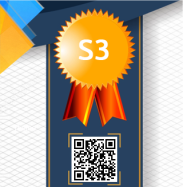THE INFLUENCE OF STRATEGIC LEADERSHIP OF ACADEMIC LEADERS ON THE MEDIATION OF PROFESSIONAL TRAINING AND STAFF PERFORMANCE
Abstract
This research aims to examine the influence of strategic leadership of academic leaders (SLAL) as a mediator between professional training (PT) and staff performance (SP) in state Islamic higher education institutions in Aceh. The study selected a sample of 526 individuals from a population of 826 within five state Islamic higher education institutions in Aceh. Descriptive statistics using SPSS version 22.0 were employed, along with Confirmatory Factor Analysis (CFA) and Structural Equation Modeling (SEM) using AMOS software version 23.0 to analyze the data, address research questions, and test hypotheses. The findings from the CFA revealed that professional training (PT) consists of five distinct factors, indicating that all dimensions of professional training (PT) contribute to the latent variable of professional training. Similarly, strategic leadership of academic leaders (SLAL) comprises seven distinct factors, representing the different dimensions of strategic leadership of academic leaders (SLAL) and contributing to the latent variable of strategic leadership. Furthermore, staff performance (SP) consists of four distinct factors, representing the various dimensions of staff performance and contributing to the latent variable of staff performance in state Islamic higher education institutions. Additionally, the study identified a significant relationship between professional training (PT) and staff performance (SP) mediated by strategic leadership of academic leaders (SLAL). This indicates that strategic leadership plays a mediating role in the relationship between professional training and staff performance in state Islamic higher education institutions in Aceh.
Keywords
Full Text:
PDFReferences
Armstrong, Michael, A Handbook of Performance Management 4th edition. New Delhi , . (2010). Kogan Page.
Avolio, B ,Promoting more integrative strategies for leadership theory-building, American Psychologist, 62(1), 25-33.
Avolio, B. J., Waldman, D. A., & McDaniel, M. A., Age and work performance in non-managerial jobs: The effects of experience and occupational type. Academy of Management Journal, 1990, 33, 407–422
Baron, R. M., & Kenny, D. A. (1986). The moderator–mediator variable distinction in social psychological research: Conceptual, strategic, and statistical considerations. Journal of Personality & Social Psychology, 51(6), 1173–1182.
Barrick, M. R.,&Mount, M. K. (1991). The Big Five personality dimensions and job performance:A meta-analysis. Personnel Psychology, 44, 1–26.
Borman, W. C. and Motowidlo, S. J. (1993) Expanding the criterion domain to include elements of contextual performance. In Personnel Selection in Organizations (N. Schmitt & W. C.Borman, eds), pp. 71-98. San Francisco: Jossey-Bass.
Byrne, B. M. (2010). Structural equation modeling with AMOS, (2nd ed.). New York: Routledge.
Comrey A, Lee H (1992) A first course in factor analysis. Hillsdale, NJ: Erlbaum. Davies, B. & Ellison, L. (2003), The New Strategic Direction and Development of the School (London: Routledge).
Davies, B. & Ellison, L. (2003), The New Strategic Direction and Development of the School (London:Routledge).
Davies, B. (2004) Developing the strategically focused school, School Leadership & Management,24(1), 11–27.
David Gefen ( 2004) ,structural equation modeling and regression: guidelines for research practice. communications of the Associations for Information Systems,vol.article 7. Georgia State University
Elenkov, D.S. 2008. Effects of leadership at strategic level and its moderators on innovation: an international empirical study. International Journal of Business Strategy, 8(2): 37–47.
Hairuddin, M. A and Inas. Z.. ( 2018) .Validating a model of strategic leadership practices for Malaysian vocational college educational leaders : A structural equation modeling approach, EJTD.Emeral publication
Hairuddin, M.A. and Inas, Z. (2017). Strategic leadership practices and students’ aspiration outcomes: what works in malaysian vocational colleges?, Al-Shajarah, Special Issue Education, pp. 77-95.
Hairuddin, M.A. (2012). The quest for strategic malaysian quality national primary school leaders. International Journal of Educational Management, Vol. 26 No. 1, pp. 83-98.
Hairuddin, M.A. (2016). The strategic leadership fundamentals for schools IIUM Press Series of TextBook, IIUMPress, Kuala Lumpur
Hartini, Sri, 2011. Pengaruh Karakteristik Demografis Dosen Terhadap Kepuasan Mahasiswa Pada Sekolah Tinggi Ilmu Ekonomi (STIE) Palangka Raya, Tesis, MSM-Fakultas Ekonomi Universitas Palangka Raya.
Hartiwi Agustina. 2012. Pengaruh Persepsi Dukungan Organisasi (Perceived Organization Support) Terhadap Kinerja Dosen Melalui Motivasi Kerja (Studi Pada Sekolah Tinggi Ilmu Ekonomi-STIE Palangka Raya). Jurnal Sains Manajemen.2012. Volume 1.N.1
Holmbeck, G. N. (2002). Post-hoc probing of signif icant moderational and mediational effects in studies of pediatric populations. Journal of Pediatric Psychology, 27, 87-96.
Hoyle, R. H., & Kenny, D. A. (1999). Sample size, reliability, and tests of statistical mediation. In R. Hoyle (Ed.), Statistical strategies for small sample research (pp. 195-222). Thousand Oaks, CA: Sage.
Hitt, M. A., Keats, B. W. & DeMarie, S. M. (1998) Navigating in the new competitive landscape: building strategic flexibility and competitive advantage in the 21st century, Academy of Management Executive, 12, 22–41
Hill C, Jones G. (2008). Essentials of strategic management, Houghton Mifflin: Boston.
Hoskisson, R., Hitt, M. and Ireland R. D. 2004. Strategic Leadership. In Competing for Advantage. South Western: Thompson.
Hughes, R.L. & Beatty, K.C. (2005), Becoming a Strategic Leader (San Francisco: John Wiley)
Ilgen, D. R., & Pulakos, E. D. (Eds.) (1999). The changing nature of performance: Implicationsfor staffing, motivation, and development. San Francisco: Jossey-Bass
Jacobs, T. O. (2002). Strategic Leadership: The Competitive Edge. Washington, D.C.,National Defense University Press.
Jaques, E. and S. D. Clement. (1991). Executive Leadership: A Practical Guide to Managing Complexity. Arlington, Carson Hall & Company Publishers.
Judea Pearl. ( 2012), The Causal Foundationsof Structural Equation Modeling, Chapter for R. H. Hoyle (Ed.), Handbook of Structural Equation Modeling ( 2012). Chapter 5, pp. 68-91New York: Guilford Press,
Judd, C. M., & Kenny, D. A. (1981). Process analysis: Estimating mediation in treatment evaluations. Evaluation Review, 5, 602-619.
Kline, R. B. (1998). Principles and practice of structural equation modeling. New York: Guilford.
Kvint, Vladimir. (2009). The Global Emerging Market: Strategic Management and Economics. Routeledge.
Linda Parker Gates. ( 2010). Strategic Planning with Critical Success Factors and Future Scenarios: An Integrated Strategic Planning Framework . Technical Report. Carnegie Mellon University
Lorraine wendy lear. (2012). The relationship between strategic leadership and strategic alignment in high-performing companies in South Africa. Ph.D. thesis.
Lord, R. G., & Brown, D. J. (2004). Leadership processes and follower self-identity. Lawrence Erlbaum Associates Publishers
MacKinnon, D. P., & Dwyer, J. H. (1993). Estimating mediated effects in prevention studies. Evaluation Review, 17, 144-158.
McMillian J. & Schumacher, S. (2001). Research in education: A conceptual introduction. (51h ed.) New York: Longman
Nelson Jagero, Hilary Vincent Komba, Michael Ndaskoi Mlingi.( 2012). Relationship between on the Job Training and Employee’s Performance in Courier Companies in Dar es Salaam, Tanzania, International Journal of Humanities and Social Science Vol. 2 No. 22 [Special Issue – November 2012]. Centre for Promoting Ideas, USA
Robert H. Pearson. And Daniel J. Mundfrom. 2010. Regular articles Recommended Sample Size for Conducting Exploratory Factor Analysis on dichotomous data: Journal of Modern Applied Statistical Methods November 2010 Vol 9 Num 2
Robert Ng’ang’a. et.al. 2013. The Relationship between Training and Development on Performance of State Owned Corporations. International Journal of Academic Research in Business and Social Sciences September 2013, Vol. 3, No. 9.
Rowe, W. G. 2001. Creating Wealth in Organisations: The Role of Strategic Leadership. Academy of Management Review, 2001, Volume 15, No. 1.
Sabenne Sonnentag, ( 2001), Performance Concepts and performance theory.
Senge, P. (1990) The fifth discipline: the art and practice of the learning organization (New York, Currency Doubleday).
Seteroff, S. (2003). Beyond leadership to followership: Learning to lead from where you are Victoria, CA: Trafford surveys: The tailored design method (3rd ed.). New York, NY: Wiley.
Simmons, C. 2007. Falling off the Apple cart. Business Strategy Review, Autumn, pp. 34-38.
Thompson, A., Strickland, A. and Gamble, J. 2007. Corporate Culture and Leadership. Crafting and Executing Strategy: Concepts and Cases (15th
Stacey, R. D. (1995). "The science of complexity - an alter-native perspective for strategic change processes". Strategic Management Journal. 16 (6): 477–495.
Zaccaro, S. J. (2001). The Nature of Executive Leadership. Washington, D.C.,American Psychological Association.
Van Dorsal, W. R. (1962). The successful supervisor. New York: Harper and Row.
DOI: http://dx.doi.org/10.22373/jid.v24i1.20276
Refbacks
- There are currently no refbacks.
except where otherwise noted.



